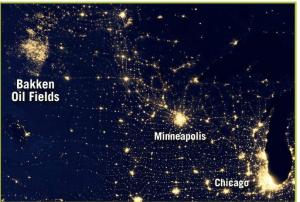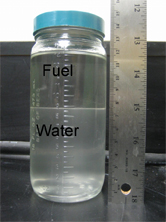
The magnitude of the many hundreds of waste gas flares burning in the remote North Dakota oil fields may best be appreciated by satellite imagery. Seen from 22,000 miles overhead, the light from all this (waste) gas burning is brighter than the lights of Minneapolis/St. Paul, and comes close to matching those of Chicago. (ChEnected covered this issue in a recent post.) The difficulties in capturing and efficiently utilizing this non-readily transportable methane are primarily ones of scale (each source being quite small) and lack of infrastructure (can you say "middle of nowhere?"). The Ceramatec corporation is working on cost-effective solutions to this challenge of energy conservation and conversion.

The conversion process
The chemical process solution proposed involves steam reforming the methane to syngas (CO and H2), followed by a Fischer-Tropsch catalyzed reaction to long chain (liquid) hydrocarbons:
- CH4 + H2O ---> CO + 3H2
- nCO + (2n+1)H2 ---> CnH(2n+2) + nH2O
The reforming is accomplished with a non-thermal plasma oxidizer as the reformer. This is a low-energy, high-voltage/low-amperage approach that only consumes 4-5 kW for 30 BPD capacity unit. A hybrid Cobalt-Zeolite catalytic systems proves optimal for this application, as they have the property of "cracking-back" higher chain length hydrocarbons, and since the target is carbon numbers of 10-20.Copper microfiber catalyst carriers are preferred for their high void volume (94%) and their much higher thermal conductivity. The F-T reaction is very exothermic (165 kJ/mole) and heat removal is a prime design constraint.
Special design and process elements to facilitate acceptable economics
- Modular to facilitate matching well-head capacity need with system(s) capacity
- Shop-built, skid-mounted systems vs. "stick-built" in the field (with associated very high labor costs)
- Attempt to use standard commercially available materials and hardware to lower cost and lead times
- Minimal expensive field labor needed to bring to operation
- Reasonable operating costs
What they'll look like

- From ceramatec.com
A F-T system of roughly 30 BPD (300k SCFD methane) capacity would be a truck-transportable unit comprised of:
- 19-4" reactor tubes of 20' length ("off the shelf" length) in a reactor shell 6' in diameter
- Dual-mode (spiral on each tube and and zonal secondary cooling in the shell) heat transfer
- Catalyst replacement using tubes pre-filled with reduced catalyst
- Ability to reassign modules to a new well site when the well output drops, as shale-gale wells are more apt to do
- Robust, reliable and reproducible

For more information on these modular methane conversion systems from Ceramatec, contact Lyman Frost at lfrost@ceramatec.com


